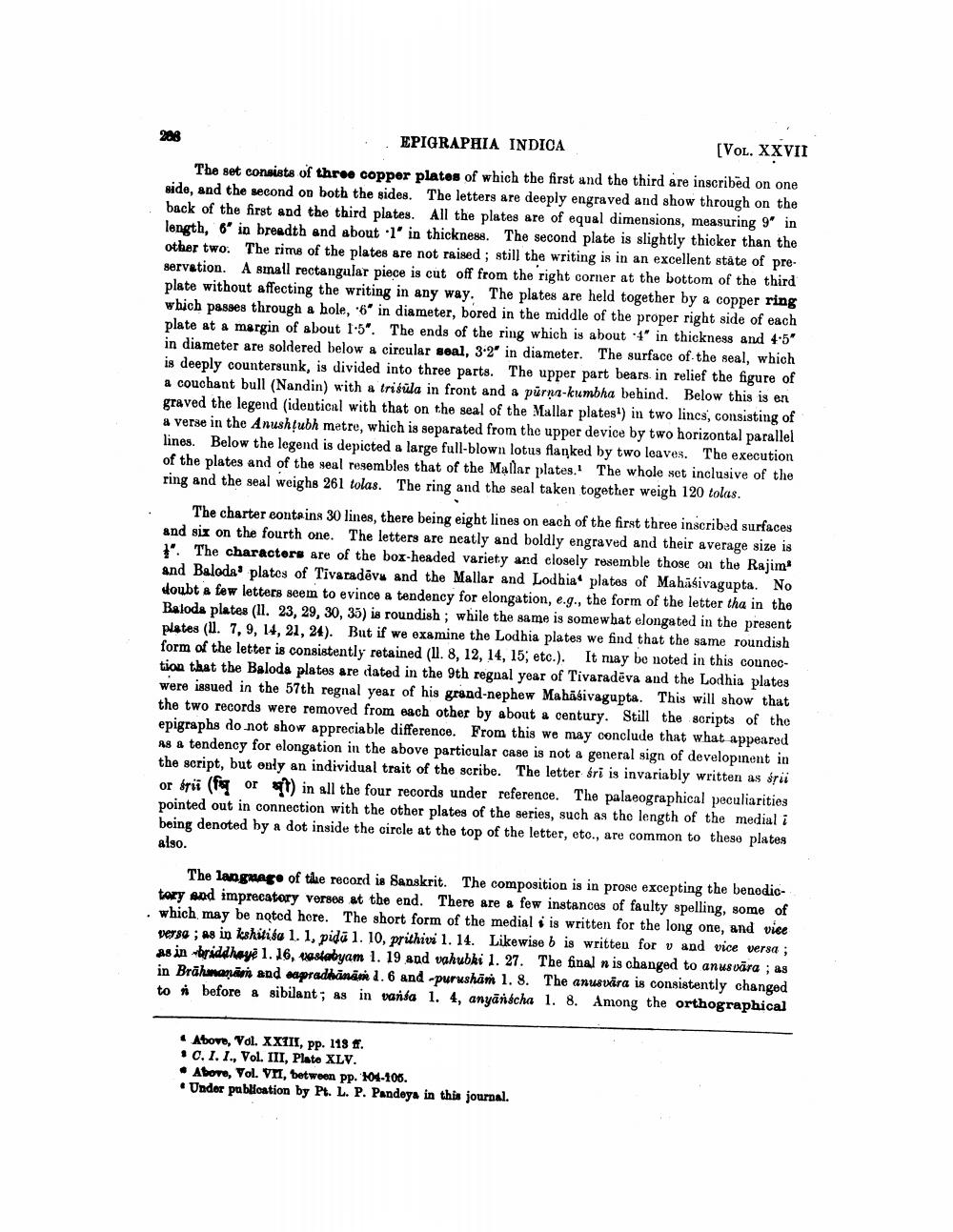________________
EPIGRAPHIA INDICA
[Vol. XXVII The set consists of three copper plates of which the first and the third are inscribed on one side, and the second on both the sides. The letters are deeply engraved and show through on the back of the first and the third plates. All the plates are of equal dimensions, measuring 9' in length, 6' in breadth and about l' in thickness. The second plate is slightly thicker than the other two. The rims of the plates are not raised; still the writing is in an excellent state of preservation. A sinall rectangular piece is cut off from the right corner at the bottom of the third plate without affecting the writing in any way. The plates are held together by a copper ring which passes through a hole, '6" in diameter, bored in the middle of the proper right side of each plate at a margin of about 1.5'. The ends of the ring which is about 4' in thickness and 4:5' in diameter are soldered below a circular seal, 3.2' in diameter. The surface of the seal, which is deeply countersunk, is divided into three parts. The upper part bears in relief the figure of a couchant bull (Nandin) with a trisüla in front and a pürna-kumbha behind. Below this is en graved the legend (identical with that on the seal of the Mallar plates') in two lincs, consisting of a verse in the Anushtubh metre, which is separated from the upper device by two horizontal parallel lines. Below the legend is depicted a large full-blown lotus flanked by two leaves. The execution of the plates and of the seal resembles that of the Mallar plates. The whole set inclusive of the ring and the seal weighs 261 tolas. The ring and the seal taken together weigh 120 tolas.
The charter eontains 30 lines, there being eight lines on each of the first three inscribed surfaces and six on the fourth one. The letters are neatly and boldly engraved and their average size is 1. The characters are of the box-headed variety and closely resemble those on the Rajim and Baloda platos of Tivaradēvs and the Mallar and Lodhia plates of Mahisivagupta. No Houbt a few letters seem to evince a tendency for elongation, e.g., the form of the letter tha in the Baloda plates (11. 23, 29, 30, 35) is roundish; while the game is somewhat elongated in the present plates (U. 7, 9, 14, 21, 24). But if we examine the Lodhia plates we find that the same roundish form of the letter is consistently retained (II. 8, 12, 14, 15, etc.). It may be noted in this connection that the Balods plates are dated in the 9th regnal year of Tivaradēva and the Lodhia plates were issued in the 57th regnal year of his grand-nephew Mahāśivagupta. This will show that the two records were removed from each other by about a century. Still the scripts of the epigraphs do not show appreciable difference. From this we may conclude that what appeared As a tendency for elongation in the above particular case is not a general sign of developinent in the script, but only an individual trait of the scribe. The letter sri is invariably written as srii or brii (fy or t) in all the four records under reference. The palaeographical peculiarities pointed out in connection with the other plates of the series, such as the length of the medial i being denoted by a dot inside the circle at the top of the letter, etc., are common to these plates also.
The language of the record is Sanskrit. The composition is in prose excepting the benodictory and imprecatory verses at the end. There are a few instances of faulty spelling, some of · which may be noted here. The short form of the medial i is written for the long one, and vice
versa: as in Kshitida 1. 1, pidü 1. 10, prithivi 1. 14. Likewise b is written for vand vice versa ; as in briddhave 1.16. pastabyam 1. 19 and vahubki 1. 27. The final n is changed to anus vāra ; as in Brāhmanarin and mapradhanase 2.6 and -purushāṁ 1. 8. The anusvira is consistently changed to before a sibilant; as in varsa 1. 4, anyānscha 1. 8. Among the orthographical
Above, Vol. XXIII, pp. 119 ff. • C. 1. 1., Vol. III, Plate XLV. • Above, Vol. VII, between pp. 104-108. • Under publloation by Pt. L. P. Pandeya in this journal.




